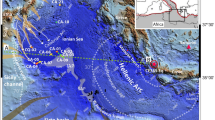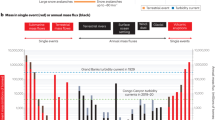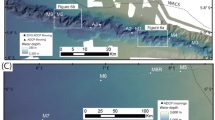Abstract
TURBIDITY currents transport massive amounts of sediment from continental margins to the deep sea. Individual flows can catastrophically remove and redeposit (as turbidites) many hundreds of cubic kilometres of material1,2, with the larger events reaching the bottom of the continental slope to form the abyssal plains3. Here we show that the age range of sediments in individual turbidites can be used directly to estimate both the thickness of failed sediment in the source region (even when its exact location is unknown) and the extent to which the turbidity current caused erosion of the sea bed. Our method involves the comparison of the abundance ratios of microfossil (coccolith) species in turbidites with those in the ocean margin sediments of the source region. Analysis of a recently emplaced turbidite on the Madeira Abyssal Plain shows that it contains a mixture of sediments with an age range of about 200,000 years, equivalent to the failure of a block of sediment about 15 m deep. Radiocarbon dating and coccolith ratios show that the turbidite contains only about 12% of recent, near-surface sediment, indicating that this turbidity current caused surprisingly little erosion en route.
This is a preview of subscription content, access via your institution
Access options
Subscribe to this journal
Receive 51 print issues and online access
$199.00 per year
only $3.90 per issue
Buy this article
- Purchase on SpringerLink
- Instant access to full article PDF
Prices may be subject to local taxes which are calculated during checkout
Similar content being viewed by others
References
Piper, D. J. W., Shor, A. N., Farre, J. A., O'Connell, S. & Jacobi, R. Geology 13, 538–541 (1985).
Heezen, B. C. & Ewing, M. Am. Assoc. Petrol. Geol. Bull. 39, 2505–2514 (1955).
Weaver, P. P. E. & Thomson, J. (eds) Geology and Geochemistry of Abyssal Plains (Geol. Soc. Lond. spec. Publ. 31, Blackwell, Oxford, 1987).
Simpson, J. E. A Rev. Fluid Mech. 14, 213–234 (1982).
Pantin, H. M. Mar. Geol. 31, 59–99 (1979).
Bagnold, R. A. Proc. R. Soc. A265, 315–319 (1962).
Parker, G., Fukushima, Y. & Pantin, H. M. J. Fluid Mech. 171, 145–181 (1986).
Weaver, P. P. E. & Kuijpers, A. Nature 306, 360–363 (1983).
Weaver, P. P. E. & Rothwell, R. G. in Geology and Geochemistry of Abyssal Plains (eds Weaver, P. P. E. & Thomson, J.). 71–86 (Geol. Soc. Lond. spec. Publ. 31, Blackwell, Oxford, 1987).
Weaver, P. P. E., Rothwell, R. G., Ebbing, J., Gunn, D. & Hunter, P. M. Mar. Geol. 109, 1–20 (1992).
Thomson, J. & Weaver, P. P. E. Sedim. Geol. (in the press).
Koopmann, B. “Meteor” Forsch-ergerbn. C35, 23–59 (1981).
Weaver, P. P. E. & Hine, N. in Stratigraphic Index of Calcareous Nannofossils (eds A. R. Lord & P. Bown) (British Micropalaeont. Soc. spec. Publ., in the press).
Embley, R. W. in Marine Slides and Other Mass Movements (eds Saxov, S. & Nieuwenhuis, J. K.) 189–213 (Plenum, NewYork, 1982).
Bugge, T. Cont. Shelf Inst., Norway, Publ. 110, (1983).
Ruddiman, W. et al. Proc. ODP Sci. Res. 108 (Ocean Drilling Program, College Station, Texas, 1989).
Thomson, J., Colley, S. & Weaver, P. P. E. Earth planet. Sci. Lett. 90, 157–173 (1988).
Erlenkeuser, H. Earth planet. Sci. Lett. 47, 319–326 (1980).
Officer, C. B. Mar. Geol. 42, 261–278 (1982).
Kershaw, P. J. J. envir. Radioactivity 2, 145–160 (1985).
Hoffman, B. W. & van Camerik, S. B. Analyt. Chem. 39, 1198–1199 (1967).
Imbrie, J. et al. in Milankovitch and Climate (eds Berger, A., Imbrie, J., Hays, J., Kukla, G. & Saltzman B.) 269–305 (NATO ASI series 1984).
Author information
Authors and Affiliations
Rights and permissions
About this article
Cite this article
Weaver, P., Thomson, J. Calculating erosion by deep-sea turbidity currents during initiation and flow. Nature 364, 136–138 (1993). https://doi.org/10.1038/364136a0
Received:
Accepted:
Issue date:
DOI: https://doi.org/10.1038/364136a0
This article is cited by
-
Calcareous nannofossil bioevents and microtektite stratigraphy in the Western Philippine Sea during the Quaternary
Chinese Science Bulletin (2011)
-
Onset of submarine debris flow deposition far from original giant landslide
Nature (2007)
-
A Deep-sea Channel in the Northwestern Mediterranean Sea: Morphology and seismic structure of the Valencia Channel and its surroundings
Marine Geophysical Researches (1995)



